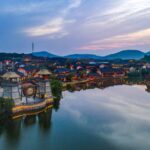Nanjing Museum is located at the southern foot of Zijin Mountain and on the north side inside Zhongshan Gate. Here, you can not only see ancient cultural relics like the golden thread garment in ‘The Grave Robbers’ Notes’, but also appreciate calligraphy and painting art. Even taking a walk on the old street can start a journey through time.
History of the museum: The museum was planned in 1933 and completed in 1948. The main hall imitates the appearance of the mountain gate of Dule Temple in Tianjin. After the expansion in 2009 and the opening to the public on November 6, 2013, it has become the second largest museum in China after the National Museum of China. There are six halls in total: History Hall, Special Exhibition Hall, Digital Hall, Art Hall, Republic of China Hall, and Intangible Cultural Heritage Hall. Layout of the museum: The main buildings of the museum are divided into two parts. After walking a certain distance on the right side is the old main hall of the museum imitating Dule Temple. It is no longer used to display exhibits but has become a place for security checks. Behind the ‘Dule Temple’ is the History Hall. The other five halls are all on the left side. You can tour from the five halls on the left to the History Hall on the right, or vice versa. It is recommended to visit the History Hall first because the Special Exhibition Hall with the ‘treasures of the museum’ is on the left side of the History Hall. You can tour the entire museum in the order of History Hall – Special Exhibition Hall – Digital Hall – Republic of China Hall – Art Hall – Intangible Cultural Heritage Hall. History Exhibition Hall: The History Hall displays cultural relics arranged in chronological order from ancient times to the Ming and Qing Dynasties. Walking among them is like strolling through the 5,000-year civilization of Jiangsu. Worth seeing are: dinosaur skeletons from ancient times; golden thread garments and silver thread garments; walls built with bricks one by one in the Northern and Southern Dynasties. Looking closely, there are faintly engraved brick carvings of the ‘Seven Sages of the Bamboo Grove’. Special Exhibition Hall: In the ‘Splendid Colors of Prosperous Times’ area of the Special Exhibition Hall are displayed official kilns of the Qing Dynasty. The ‘Exhibition of Fine Clocks and Watches’ displays ancient Chinese timekeepers and Western clocks and watches. In ‘Approaching Buddhist Statues’, there are glittering and exquisite Buddhist statues. And the ‘treasure of the museum’, a gilded Tibetan-style stupa from the early years of Zhengtong in the Ming Dynasty (1436 – 1439 AD), takes up an entire room for one exhibit. Just that grandeur is enough to be shocking. This treasure of the museum was unearthed from the underground palace of Hongjue Temple Pagoda in Niushou Mountain, Nanjing. On the square red sandstone base, four blue and white porcelain vases surround the golden stupa in the middle. In front of the stupa is a small golden coffin and silver outer coffin. On the coffin lies a golden reclining statue of Sakyamuni. Digital Hall: The Digital Hall uses modern technology to display ancient themes. Exhibits such as the animation ‘Scenes of Prosperity in Nanjing’ (similar to the ‘Along the River During the Qingming Festival’ in the China Pavilion of the World Expo). What’s more interesting is that there are many interactive games here. You can touch the screen to play games with ancient backgrounds. Art Hall: The Art Hall displays sculptures, calligraphy, and paintings. The paintings of Fu Baoshi on display, using Chinese ink wash to paint red-roofed buildings, squares, and sculptures in Eastern Europe, are still very unique.The Republic of China Pavilion is designed to resemble the streets of that era. Trolley cars are displayed on the streets, and shops in the style of the Republic of China line both sides, all open for business and selling items that evoke memories. In a grocery shop selling both southern and northern goods, you can purchase the ‘rat droppings’ (also known as kumquat pills) that you might have eaten as a child. The post office offers Nanjing Museum postmarks, and the bookstore on the upper floor of the post office, called the Pioneer Bookstore, has staff dressed in period attire and sells stamps for postcards.
The Intangible Cultural Heritage Pavilion showcases folk handicrafts such as woodblock printing, paper-cutting, gold foil, and lanterns. Performances of Kunqu Opera, Baiju, and Pingtan can be enjoyed here, with performance times ranging from 14:00 to 16:00. In the small theater, a free 3D movie is available, with a duration of approximately 20 minutes. On weekends and holidays, the small theater of the Intangible Cultural Heritage Pavilion opens at 19:00 for traditional performances, for which tickets are required. The museum is closed all day on Mondays throughout the year; from July 9th to August 31st, it is open from 09:00 to 18:00 on Tuesdays to Sundays; from September 1st to July 8th, it is open from 09:00 to 17:00 on Tuesdays to Sundays; during the National Day holiday, it is open from 09:00 to 21:00. Service facilities include guided tours, with voice-guided tours costing 20 yuan and smart-guided tours costing 30 yuan. Guided tours are available at 10:00 in the morning and 14:00 in the afternoon, with meeting points at the History Pavilion’s information desk, the Special Exhibition Pavilion’s information desk, and the Art Pavilion’s information desk. Audio guides are available for rent, free of charge, at the information desk. There are free timed tours at 10:00 AM and 2:00 PM daily at the History and Special Exhibition Pavilions, with prior announcements made over the PA system, each tour accommodating up to 30 people.








